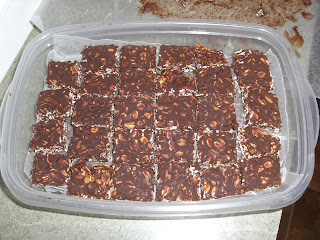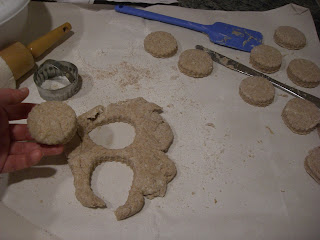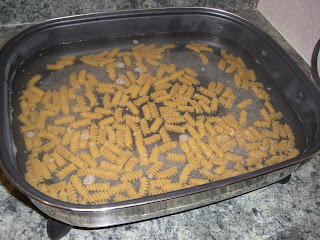These are so much fun, especially with children. I have many fond memories of making pepparkakor. Before I share the recipe, here are some things I've learned over the years to make it work well. Some of this is just common sense and some of it is experience. Maybe it'll save you a bit of time, money, and frustration. But feel free to skip to the recipe if you want.
The dough must be cold for you to roll it out. That means you get out your container-the-dough-was-chilled in, take out a lump, and put the container back in the fridge before you roll out your dough. When you've cut out all the cookies you can cut out, put the scraps back in the fridge. If you try to roll them out again, you'll get a sticky mess. Use a freshly chilled lump instead.
Do not try to make a double batch of this dough unless you have an industrial size mixer. You will get a floury mess (and perhaps a broken mixer). A single batch makes plenty of dough, enough to keep you busy for hours.
Also, do not decorate the cookies with the cookie sheets on the stove (unless you have one of those completely flat stoves with no crevices). The sprinkles will get into the crevices on the stove. When you cook dinner on the stove, the sprinkles will melt and you will have a very colorful mess that is nonetheless very difficult to clean up. Put the cookie sheets on an easily cleaned counter or table so that you can wipe all the sprinkles off when you are done. It took us years to learn this, though I'm not quite sure why.
We never decorate our pepparkakor with icing, although you can do that after you bake the cookies. We decorate the cookies before we bake them using colored sugar (Mom's favorite), sprinkles (my favorite), and mini M & Ms (to which nobody objects). My sister likes to use colored sugar to give all the gingerbread boys blue pants and red shirts, and all the Christmas trees get green sugar with a yellow M & M on top for the star. The gingerbread girls get pink dresses, the stars get yellow, and the holly leaves get green. I'm not quite so methodical. I think sprinkles taste better, anyway.
Buy your sprinkles off-season if you can. After the holidays, you can find holiday-themed sprinkles at a steep discount. (After Halloween, I got some chocolate sprinkles, leaves, and orange sugar for 75% off.) You can often find multi-sectioned containers of sprinkles (at reasonable prices) at Ross, TJ Maxx, Marshalls, and HomeGoods, in the food aisle. Do not bother getting nonpareils (the little round balls, either white or multi-colored). They don't stick to the cookies. We've tried many times. (But you can press them into the centers of
these cookies instead of nuts, and they'll stay there. It's the only use I've found for them yet.)
You will not get all the sugar and sprinkles on the cookies, no matter how hard you try, and some of your sprinkles will roll off. You can, however, reuse sprinkles. Bake your cookies on parchment paper, and after you've taken the cookies off, lift the parchment paper and guide the sprinkles left behind into a small bowl. Now you have multi-colored sugar-sprinkles mix that can be used just like regular sugar or sprinkles. I like putting it on stars and snowflakes, because it's cheery. To make it easier to use your sugar-sprinkles mix, put it into an empty sprinkles container and shake it on from there.
(Note: Parchment paper is a fantastic invention. It's paper that you can put on your cookie sheets instead of greasing them. You can use it over and over again, until it starts looking brown or yellowish around the edges, and you never have to wash your cookie sheets, because the cookies never touch the sheets. You can also lay out your cookies on parchment paper while the cookie sheet is in the oven baking more cookies, but I wouldn't decorate them until they're actually on the cookie sheet, because the sprinkles may fall off as you transfer it.)
I prefer using small cookie cutters. The cookies are very thin, and the smaller the cookies are, the less likely they are to break when you store or transport them. Mom sometimes quarrels with me on this--she still likes using the big cookie cutters sometimes--but she can't deny that the big ones break more easily. So the small cookie cutters are much better.
Get your cookie cutters off-season, too. Last year we found some lovely ones at Michaels a few days after Christmas. I think we got 20 small ones for $2. Joann's also has baking supplies. If you do small cookies, you will want to invest in some cookie cooling sheets that have a cross-hatch pattern (not just lines straight across), so that the cookies don't fall through and break. Michaels and Joann's often have 40% off coupons in their circular.
Since you roll out the dough very thin, some of the unbaked cookies will not transfer well to the cookie sheet. This is inevitable, although it's more likely if the dough is getting warm. Make sure your pastry cloth or work surface is well floured (along with your rolling pin and hands), and dip cookie cutters in flour before cutting out cookies. You can use a small metal spatula to help transfer cookies, but some of the shapes just don't do well--I remember having particular trouble with the dalarna horse and the reindeer, since their legs are so thin. If a cookie fails, put it in a lump to the side and return it to the fridge the next time you get the container out.
Pepparkakor (Swedish Gingerbread)1 cup sugar
1/2 cup shortening
1/2 cup (1 stick) butter or margarine
2 eggs
1/2 cup molasses
3 1/2 cups sifted flour (or spooned LOOSELY into measuring cups and leveled with a flat knife. Do not shake measuring cups as you spoon flour in, because this packs it in tighter.)
2 teaspoons soda
1 1/2 teaspoon ginger
1/2 teaspoon cloves
1/2 teaspoon cinnamon
1/2 teaspoon nutmeg
1/4 teaspoon salt
In mixer, mix together sugar, shortening, butter, eggs, and molasses. Sift together dry ingredients (or--sorry, Grandma, but I never use a sifter--combine them in a separate bowl using a whisk) and stir into sugar mixture. Cover and chill several hours or overnight.
Heat oven to 375 degrees. On lightly floured board or pastry cloth, roll out a small amount of dough about 1/8 inch thick. (Keep remaining dough refrigerated.) Cut with floured cookie cutters. Place on ungreased baking sheet. Decorate with colored sugar and sprinkles if desired. Bake 6-8 minutes. Caution--they burn easily. (After they cool, you can decorate them with icing if you haven't already decorated them.)




































